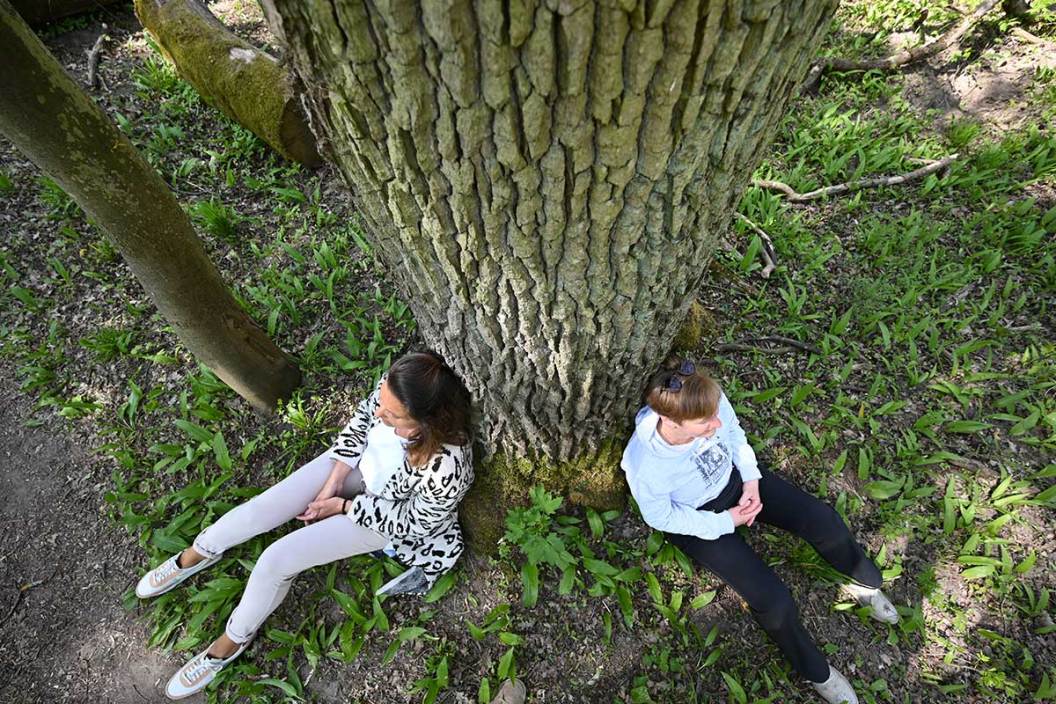The notion of "forest therapy" isn't new or far-fetched, but instead is a real, tangible therapeutic strategy we've known about for a long time.
Forest therapy, the simple therapeutic act of spending time in a forest, is rooted in Shinrin-yoku, the Japanese practice of "taking in the forest atmosphere" or "forest bathing."
The term emerged in Japan in the 1980s as a physiological and psychological exercise defined as "making contact with" and "taking in the atmosphere of the forest." The purpose is twofold: to offer an eco-antidote to daily-grind burnout and to inspire humans to reconnect with and protect the forests.
Shinrin-Yoku practitioners greatly respect trees and believe that they are the protectors and wise watchers of the forest. But it's not a literal bath; the term refers simply to immersing yourself in the atmosphere of the forest; it's an associative practice that brings people into deeper intimacy with natural places.
Forest Therapy Explained
The beauty of the outdoors naturally encourages people to go outside, inhale fresh air, listen to the birds, take a walk, or watch the wind animate the branches of the trees. This is, in its essence, forest therapy. This practice offers activities designed to create experiences that enhance connectedness to nature and the self, strengthen social relationships, and boost the therapeutic and restorative effects of nature for human health and well-being.
The experience as such, psychologically and spiritually speaking, is seen in humans intuitively as relaxing, soothing, and experiencing awe-inspiring effects just by being in or viewing forests, plants, flowers, parks, beaches, and other natural settings.
Forest therapy, in some form or another, has been a round a long time. Historically, Cyrus the Great intuitively built lush green gardens in the crowded urban capital of Persia 2500 years ago to increase human health and promote a sense of "calm" in a busy city.
Furthermore, current literature supports the comprehensive health benefits of exposure to nature and green environments on human body systems. Nature has shown great benefits for the human brain, shown through increased happiness, health, well-being, and cognition along with improved sleep quality, mood, and heightened focus.
Trees give off phyto-chemicals called phytoncides that have antimicrobial properties influencing improved immune systems. For many, this also comes with additional benefits such as an improved sense of self and body image, mental strength and stamina, enhanced confidence, and improved self-awareness.
In fact, a field study conducted in 2010 within 24 forests across Japan showed that forest environments promoted lower levels of cortisol (a stress hormone), lower pulse and blood pressure, greater parasympathetic nerve activity (increased relaxed state), and lower sympathetic nerve activity (decreased anxiety) in those who walked and viewed forest areas.
These results further led to the development of research dedicated to forest medicine, a strategy of preventative medicine, and a consideration for practicing Shinrin-Yoku to decrease undue stress and potential burnout. Forest therapy does wonders for interpersonal relationships as well. Practicing Shinrin-yoku in a group is known to improve group cohesion, empathy, and overall interpersonal dynamics.
How to Start Forest Bathing
So how does one go about forest bathing?
The actual practice of Shinrin-Yoku is very simple: take a few hours out of your busy life, head to a densely forested area, and let the trees do the rest.
A two-hour forest bath will help you unplug from technology and slow down from your daily mundane activities. It will bring you into the present moment, de-stress and relax you.
But what if you can't regularly cut out two hours? The good news is that even a small amount of time in nature can have an impact on our health. Take the time to breathe deeply and turn your focus inward to the self. No hiking, running, or mountain-climbing is necessary. You can even just sit if you want to. It is important to find a place that suits you, as there is no one-size-fits-all solution - the ideal forest therapy technique differs from person to person.
The real key to unlocking the power of forest therapy is in the five senses. Let nature enter through your ears, eyes, nose, mouth, hands, and feet. The sights, sounds, and smells of the forest take us right into that moment so our brains stop anticipating, recalling, ruminating, and worrying.
Take a moment to appreciate your surroundings and listen to the sounds around you: twittering birds, a rustling bush, trickling streams; breathe in the clean, fragrant air and soak in the feeling of the earth and shapes of the leaves and branches dancing in the wind. Touch the dirt and green moss, turn over differently shaped stones, and smell the rough bark on the trees.
Use pine-needles to make art, draw in the dirt with a stick, or lay back and make pictures in the clouds. Let the stillness embrace you and alter your state of mind and make you forget the constant bustle of the non-natural world.
This is a sensory experience. In a forest, meditation and mindfulness come naturally when you allow your senses to focus on the small, uncomplicated changes around you.
First Hand Forest Therapy
This short PBS documentary on Forest Bathing further tells the story.
As the documentary points out, this practice is scientifically proven your physical health as well as mental health. Shinrin-Yoku helps to lower your heart rate, reduce your blood pressure, decrease stress hormone production, boost your immunity, enhance your mood, and improve your overall feelings of well-being.
You can forest-bathe for as little as 20 minutes virtually anywhere; in the morning or the evening; in hot weather or in cold; in rain, sunshine, or snow. You don't even need a forest to achieve the same sort of wellness in a natural environment. Once you have learned how to do it, you can do Shinrin-yoku anywhere - even in a nearby park or in your garden.
To learn greater mindfulness and openness to nature's healing powers, forest therapy allows you to leave your screens, your deadlines, and your worries behind. It's worth it — even if you can only spare a few minutes.
READ MORE: MOVIES ABOUT HIKING AND THE WILDERNESS




